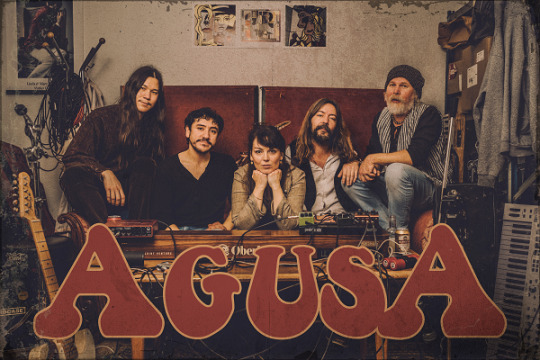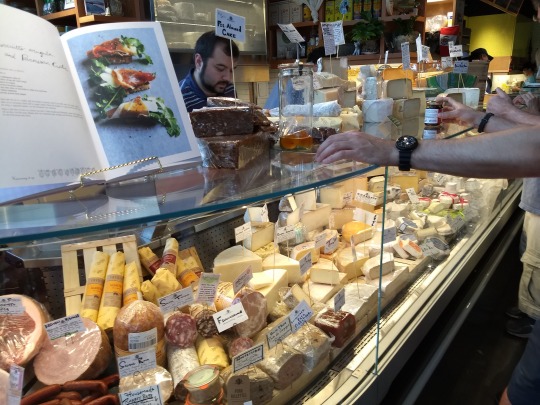#latin kraut
Explore tagged Tumblr posts
Text
youtube
Can - Come sta, la luna
#can#come sta la luna#michael karoli#holger czukay#irmin schmidt#jaki liebezeit#krautrock#progressive rock#latin kraut#soon over babaluma#1974#Youtube
1 note
·
View note
Text
KARISMA RECORDS INKS DEAL WITH SWEDISH PROG ROCKERS AGUSA
Karisma Records have inked a deal with Swedish Prog Rockers AGUSA that will see the label re-release the band’s first five studio albums. AGUSA has been at the forefront of the Swedish Psychedelic Prog scene since the band’s formation in 2013. Based in Malmö, Sweden, AGUSA’s lineup of Simon Ström on bass, Nicolas Difonis on drums, Mikael Ödesjö on guitar, Roman Andrén on keys, and Jenny Puertas…

View On WordPress
#Agusa#Jazz#Karisma Records#Kraut Rock#Latin American Folk#Nordic Folk#Prog Rock#Progressive#Progressive Rock#Space Rock#Sweden
0 notes
Text
I decided to take @lightineventide up on their open tag and try this tag game because it looks fun :)
Rules: Make a poll with a bunch of truths and one lie about yourself (at least 5, more if you want) and see which one wins
Curious what you think. If you know your cílil lore, you should have a decent shot ;)
No pressure tags: @a-world-of-whimsy-5 @i-did-not-mean-to @sauron-kraut @tar-thelien @tauw-nu-fuin
@camille-lachenille @fishing4stars @mirkwood @curufiin @nighttimepatrons
@uruk-thighs @maglor-my-beloved @chrissystriped @crackinthecup @urwendii plus open tag for everyone who wants to join!
22 notes
·
View notes
Text
Luce is not surprising to anyone tbh, when the Latams already had anime Guadalupe like a decade or so ago. Even less surprising because Pope Francis is an Italian-Argentinian Jesuit.
Truly the grace of having a proper latin pope again instead of another joyless Polack or Kraut.
8 notes
·
View notes
Link
Dreckig: Diskotekte kıyamet havası https://futuristika.org/dreckig-diskotekte-kiyamet-havasi/ Dünyanın son gününde dans edecek gibi gözüken Cumbia elektro grubu Dreckig ile söyleşi. Biraz kraut, biraz latin, eriyen beyin. #Cumbia #Dreckig #Krautrock #Söyleyiş #Tablatura
2 notes
·
View notes
Note
Your Latine anon and my kraut anon should get married.
OMG YES!!! True love at first sight.
1 note
·
View note
Text
On'yomi, or it's all Greek to me
(I'll describe something really useful for memorizing the on'yomi readings of many kanji at the end of the article, so you might also want to skip ahead. It's the part with all the kanji in it, can't miss it, really.)
When you learn Japanese, you learn many facts that sometimes make you wish you didn't. You happily beaver away at learning to write kanji only to pick up on the fact, that Japanese has two predominant ways to read almost any kanji: on'yomi and kun'yomi.
You could on'yomi "the Chinese readings" and kun'yomi "the Japanese readings" and you would be both right and wrong. So very wrong.

Well, not entirely. The notion is actually useful. On'yomi are readings derived from the evolving Chinese language of different time periods but pronounced wrong. (Remember, Japanese doesn't emulate Chinese pitch and has a limited set of sounds.) And the kun'yomi preserve various readings from various parts of Japan that were the sounds of the original Japanese language predating the Chinese writing system. (Get the deets here.)
Wait. If you have native Japanese sounds, why do that? Who on Earth would do such a thing!?

Right. It's us! (I'm German.) German uses words derived from Latin and Greek a lot in spite of perfectly usable German words meaning the same or similar things. So I'm the one to talk, huh?
"die Intention" - the intention. Perfectly German word? "das Vorhaben," or better, "die Absicht."
"die Prätention" - basically to give yourself airs. Perfectly German word? "die Anmaßung."
"die Restoration" - the restoration. Perfectly German word? "die Wiederherstellung."
Latin was the language of the Roman empire, but this impacted more the cultures abutting the Mediterranean and their "Romanic" languages - Spanish, Italian (of course), and French, for example. The basic stock of the language took in a lot of Latin words, they are at the core.
Germans on the other hand, thanks to "Herman the German", stayed mostly independent from the Roman empire and played part in eventually bringing it down. These proto-Germans had their own language to start with, and probably some form of sour kraut. So why all the Latin and Greek?
Latin is the language of many academic professions, especially law (Roman law is the historic origin of most western law) and medicine (partially with the intention you don't understand what your doctor is saying about you!). Universities in the middle ages and beyond relied on Latin as the language of exchange. Newton wrote about gravity in Latin. (And lots of other things. A busy bee, Newton was.)
These pesky academics then went on the coin all kinds of complicated words for newfangled technology that the ancient Greeks and Romans surely had envisioned at some point. Now wait. That was Jules Verne.

Television - far-away seeing. Oh wait, no, that's telescope. My bad.
Automobile - it moves by itself.
Mobile phone - movable sound.
Arithmetic - something about numbers and counting.
Algorithm... Ha! Gotcha! Sounds Greek, right? It's derived from the far more accessible Arabic...
My examples are English but exactly the same words exist in German with minor spelling differences - "Television" oder "Fernsehen", "Automobil" or simply "Auto," "Mobiltelefon" or simply "Handy" (say what?), "Arithmetik" and "Algorithmus."
So, we're a mess, huh? Germans can't speak German without resorting to Latin, Greek, English ("Computer", "Handy"), a bit of French, Italian, Yiddish... and we mangled most of it. We can't help it. Most of it we translated to our own sounds. (That will show our neighbors and compatriots what we think about their invasive words. We'll use them but make you cringe.)
Don't get me started on English. A Celtic language mostly overwritten by Anglo-Saxon Germanic invaders with Frisian partially overwritten by originally Norse French (Norman) invaders, stuffed to the brim with Latin and not even the same root word for an animal and its meat. (Eventually, veganism might take care of that one.)
Deep breath. It's fine now.
Compound words
Now that was a lengthy excursion amounting to nothing, right?
Well, get used to it.

If you use a single kanji word, you typically use the kun'yomi sound. Because there was already a Japanese word representing that concept when writing arrived. Also, this is true of most verbs, adjectives, and adverbs, and some compound words (featuring multiple kanji). The tell-tale sign is typically the presence of some hiragana when writing it.
There are adjectives that don't have hiragana, like "dislike," one of the meanest little effers in the Japanese language. Its sounding ("kirei") ends in -i, but it isn't an i-adjective. It is an adjective, but it doesn't have any hiragana attached, either. It's a na-adjective that ends in -i. There are good reasons to dislike "dislike."
But in general the presence of hiragana puts you firmly in the territory of the kun'yomi readings. So a lot of common Japanese is unsurprisingly native sounds, just as English has native words for house, car/cart/carriage, like/likable, so does Japanese ("ie", "kuruma", "suki").
The category where you however will be inundated with on'yomi readings is the one of the vast majority of compound words - many of these complex concepts were imported from China. And so was the way to sound them out. Somewhat. Kind of.
In other words, Chinese fills the same role for Japanese that Latin fills (and, to some extent Greek, also) for European languages.
A useful shorthand
So, if you have to learn two or more readings for most kanji, how do you keep track? And do kanji make any sense?
Reading "Remembering the Kanji" originally raised my hopes that kanji were logical only to shatter those very same hopes over time. But it simply approached its subject matter from a limited view. At least the first book. (But that's how you're supposed to memorize the kanji, and I do call bullshit on that.)
Only the most simply kanji are pictograms. They depict the sun and moon for day and month, or the mouth, they clearly express 1, 2, and 3, etc. So I originally thought it might be useful to get a book about their origin to remember them.

Frankly, kanji (or more correctly, hanzi) changed so much since their time as petroglyphs they've become unrecognizable. Don't bother, really.
But that doesn't mean there is no sense in kanji at all, especially when it comes to the Chinese readings.
More complex kanji were built from simpler kanji - or from alternative forms of writing these kanji. People nowadays mostly learn them through memorization, but the radicals (as the parts of kanji are called) contain clues to their meaning and to their on'yomi reading.
You could go and use this as your method for memorizing the kanji, in fact. The book "The Kanji Code" by Natalie Hamilton lays out one such method. But you can have the benefit a bit easier, I think.
So, if you have a complex kanji, one part might give you the category of its meaning, and another part the sound. You can call them "signal primitives" if you want.
Here's an example:
謝 means "apologize" and its on'yomi reading is "sha."
言 is a hint to its meaning category, it means "say."
射 is a hint to its on'yomi reading, it reads... "sha!"
Here's another example:
養 means "foster" or "bring up" and its on'yomi reading is "you."
食 is a hint to its meaning category, it means "eat" or "food."
羊 is a hint to its on'yomi reading, it also reads "you."
So the original combinations might seem nonsensical at first:
"Apology" (謝) isn't a combination of "say" (言) and "shoot" (射).
"Foster" (養) isn't a combination of "food" (食) and "sheep" (羊).
But if take both these kanji as a way to tie together a broad meaning category with a sound, we do get a good result.

In fact, look at this example:
寺 is the kanji for "Buddhist temple" and its reading is "ji."
痔 means "hemorrhoids", meaning radical is "sickness" (疒) and pronounced ... "ji." (Hey, they were probably the first culture to spend long days sitting and writing.)
時 means "time" or "hour", meaning "sun/day" (日), and pronounced (you guessed it) ... "ji." (Time is indeed tied to the sun.)
持 means "hold", meaning "hand" (扌), and, yes, "ji."
峙 means "(to) tower" (like "towering over someone"), meaning "mountain" (山), and again, "ji."
Congratulations, you just learned four additional kanji in one go by looking at their components (which you do have to know) and spotting which part is the "meaning category" and which part a clue to its on'yomi sound. (Also, none of these words do in the least relate to the concept of a Buddhist temple.)
If you're interested in learning more about this method, have a look at the book. You might find it up your alley.
But even if you don't use the book, you can always look at each kanji you learn and check if the reading is "hidden" somewhere as part of the kanji already. This reinforces your memory of the original kanji's reading and helps you make sense of complex kanji.
0 notes
Note
Magical realism AU.
heed the tags. this got rough.
the war setting is perfect for magical realism (considering how magical realism as a literary genre was created, partially, as a response to like... the hardships and violence caused by political strife and imperialism in latin america). things happen, and the weird part isn't that they happen. the weird part is that nobody cares.
or, more precisely, everybody is too exhausted to care.
some green replacements go missing. everybody shrugs, and the reasons are endless; got picked off by krauts during patrols. got killed in mortar rain. got taken and fed to their latest parasitic lieutenant to add to his layers of fat, of carelessness, to keep him warm, while his soldiers shiver in the snow, starving and half dead. a eucharist only those most devoted must consume. take this body, this boy who begged for his life, for god gave you this meat to sustain you. eat. eat. take this drink, the blood of a virgin, too young to shave, too young to drink. mix it into your coffee. feed. feed. keep warm.
nobody says anything.
deep in the bastogne woods there is a tree, and in its twisted roots there lays a child. bundled up in warm, cozy sheets of army green, crisp and pretty like fresh fruit on a summer day. nix touches it, and its skin is cold as ice. yet it breathes. he tries to take it, but the tree holds it tight. that night, he dreams of the baby he'd left behind. hears the squeaky voice mutter; daddy. daddy. before it warps and stretches into a singular howl that thrusts him into wakefulness, here in his foxhole. grave. surrounded by dirt with the blue grey sky hanging, overwhelming and mocking, overhead.
he returns to the tree and finds the blankets, but not the baby. he takes those and drapes them over dick's shivering shoulders.
neither of them say anything.
renee whispers in eugene's ear: three pieces of chocolat. three wishes. use them wisely. use them sparingly. but never use them selfishly. one, two, he uses on dying men. they live. three, he swallows for himself. forget, he says. forget. forget. forget. forget so i can work. forget so i can be better. faster. save more. he wakes to mortar rain and a large blank, as white and empty as the snow on no man's land that stretches before them. mortar rain falls. babe shakes him awake. when he returns to the church, it is gone, and an ash-stained hand lays, crushed under the stones, outstretched and placating, forgiving in its stillness. he has forgotten, and the remembering has hurt him all the more.
eugene tries to vomit, but its settled into the lining of his stomach like led. he bandages babe's hand. says his name. but other than that, he says nothing.
web lays in his hospital bed. the boys in the bed next to his keep changing. but are all the same. they scream into the night, but come morning they are silent. then they are nothing. the numbness in his one leg then claims two. he sleeps, and when he's back to wakefulness, the numb has overtaken his belly button and lays in wait, now. the next night, he hears commotion-- sneaks out and witnesses a girl, a nurse, who has done nothing but help, being torn apart by men with shadows in their eyes, consuming their lives. the numb crawls further. he enters the replacement depot, sees boys, young as he once was, wide eyed and shaking. fear has a smell. david can taste it. the numb crawls to his chest. takes one arm. johnny tells him about hoobler, the numb takes the other. jackson dies. the numb crawls up his collar. he attempts to take it back, the ability to feel, to connect on that primal level, to feel less alone. but all attempts plunge him deeper and deeper into the dark. those german soldiers shot in the head. landsberg. the baker. it advances.
so, he lets it.
by the time he's blinking in the austrian sun, the numb has engulfed him, and he sinks into it like a stone in water. he says; "any one would run." then, he says nothing more.
there is a flower that never dies and it lives in ron's pocket. small. delicate. over the course of the war, it has bloomed. but at his expense. the roots have settled now. settled into his hip, burrowed into his skin. wrapped and twined around his veins until they are sustained by his blood instead of its green, fresh chlorophyll. until its white petals have turned pink and now, deep deep red. pulsing with a heartbeat that is timed to his own. thump, thump, thump.
he watches the baseball game and it bleeds, sending rivulets of crimson down his leg. everybody sees.
nobody says anything.
#ask#magical realism#cannibalism#death#depression#blood#body horror#rape implied#bob aus#winnix#eugene roe#david webster#ronald speirs
15 notes
·
View notes
Text
bringing the war home. (adelard dekker & gertrude robinson. hurt/comfort. rated m. 1.4k words. genfic.)
They're on the train when Gertrude notices the trembling.
Dekker's hands are scarred, thick with blisters, shiny with small burns. They're the hands of a solider. Only these days, they're the hands of the grocer who bags her flour, of the banker who cashes her cheques, of the conductor who waved them onto the train, and of the vicar who sits next to her and shakes.
AO3 link. Written for TMA H/C week organised by @themagnuswriters. CW: non-graphic canon-typical Slaughter-related deaths, references to PTSD and war.
Gertrude finds Adelard Dekker in front of Winchester Cathedral.
Even from a distance, he is easy to spot, his cassock a stark black against the broad expanse of slate-grey stone and sky. She knows that he is a well-built man, but alone and swallowed up by the bleached landscape, he looks much smaller.
She walks smartly up to him, her footsteps echoing loudly around the close. "Mr Dekker," she says, holding out her hand.
"Miss Robinson," he says, smiling and taking her hand. "I appreciate your coming out here."
She does not say that she appreciates being asked, that she was surprised he had called, that there are precious few men in their business who accept her advice, let alone actively seek it out. There’s no need to voice that. They are both outsiders in this world, and they both know it. Instead she says, "Your call sounded urgent."
Dekker sighs. It is not rude, rather it is a bone-deep exhaustion ill-suited to a man his age. "A man killed his parents then himself. Did it with a spanner." He adds, "I thought it best you saw the scene for yourself."
Gertrude nods. "The Hunt?"
He pauses for a moment, hesitating. "That's what I thought," he says, expression grim. "But there wasn't any pursuit, no challenge, no chase. It's not like any Hunt I've ever seen."
She waits, but he doesn't seem keen to elaborate. That's alright, she has time. She hums noncommittally and follows as he leads her through the cloisters and out into the city. - The house, when they arrive, is unmistakable. It's standard aspirational middle-class, a modest red-brick with a neat lawn and bicycles leaning unlocked against the fence posts. It's also got three police cars surrounding it, arranged to shield the public from view as much as possible.
Dekker strides confidently past the uniformed officers. "Here for the family," he explains lowly, straightening his cassock when they move to stop him. They back off, nodding sympathetically.
It's a good act, and Gertrude is preparing to say as much, when they enter the living room, and the words die in her throat.
Bodies are nothing new to her. Nor are torn-off limbs and bloody tableaux. She skipped past more than she could count as a child, running to school through the smoking ruins of London. Somehow it's different when it's like this: so much bloody brutality, a rage so powerful that it's tangible, bodies not just battered but pounded into a formless pulp.
The perpetrator is a little better, physically incapable of wreaking such damage on himself, but still accomplishing more harm than Gertude would have thought possible. Her stomach turns, and she forces herself not to show it.
"Shell shock," explains the detective attending. He is a hard-faced man, who walks with a limp and a permanent scowl. "Records say he was a POW with the Krauts," he says, face screwed up with disgust and grief and an old exhaustion. "What they did to those boys," he pauses and shakes his head. "Doesn't take a genius to know why he snapped."
It's not the Hunt, but it’s not shell shock either. - They find it in the dead man's room, on a disordered bookshelf jammed full of thick volumes: a small red-brown book with a cover made of something that isn't quite leather, embossed with faded Latin lettering.
Gertrude curses and drops it on instinct, feeling the impression of the words even through her gloves.
They both stare at the thin volume, lying incongruously on the woollen carpet. The room does not change in any measurable way; there is no ominous thickening of shadows or dropping of temperature, but there is something, like the world took a step to the left and became that little bit less certain, less safe. Gertrude's skin crawls and she flexes her hand uncomfortably.
Dekker drops to his knees beside the book, picking it up in carefully gloved hands and carrying it over to the dead man's desk.
"Don't open it," Gertrude snaps. She has seen men with far more experience than Dekker doom themselves in a moment of thoughtless excitement.
She needn't have bothered; he barely seems to hear her, too busy tracing the words of the title, quis carmine caedes diversas. His dark skin is pale, lips tinged a sickly grey. "That's from Vergil," he says slowly. "Who can sing of such varied slaughters," he recites, with the easy cadence of words long committed to memory. "It's from a battle scene."
And Gertrude knows why Dekker called her. "War rage," she says, feeling the knowledge crawl oil-slick up her throat.
Dekker nods mutely.
"The Slaughter."
He nods again, and now the understanding is choking. She slumps into a chair.
"Indiscriminate killing, random acts of violence" she says quietly. "I suppose, there's nothing about that unique to wartime." A heavy stillness falls, the only sound the muffled ticking of the room's clock. "Foolish, but I had tho—" she breaks off. "I had hoped it couldn't manifest in peacetime."
"That had— that had been my hope too," says Dekker. There's something awful and strangled in his voice, something born far away in a European field to the rattle of gunfire.
It's not exactly a surprise. The Fears have never limited themselves to what is convenient or logic, there's no reason that this should be different, no matter how much she had ached for it to be. It tastes more like the bitterest disappointment, in the world for being as cruel as ever, in herself for thinking it could be otherwise.
Dekker cuts through the silence with a chuckle, humourless and empty, the kind that hurts to hear. "I really thought I'd never see that again," he says, voice cracking horribly. He shakes his head, and his eyes are too bright. "Should have known better."
Gertrude looks away. The moment is too personal, too raw, fresh pink scar tissue splitting to reveal the thick red gore underneath. - They leave the house twenty minutes later, the book wrapped in Gertrude's bag and Dekker's cheeks carefully dry. The walk to the station is heavy with the quiet kind of companionship that comes after an event leaves one hollowed - empty of action, of feeling, of words.
They're settled into their compartment, safely on route to London, when she notices the trembling.
Dekker's hands are scarred, thick with blisters, shiny with small burns. They're the hands of a solider. Only these days, they're the hands of the grocer who bags her flour, of the banker who cashes her cheques, of the conductor who waved them onto the train, and of the vicar who sits next to her and shakes.
Later Gertrude will wonder at herself; she is not a soft woman, not easily given to pity or patience. Theirs is a business that disdains weakness, but in the moment Dekker's hands are shaking, and she is barely thinking.
Gertrude reaches across and takes his hand in hers.
Dekker's hand is warm and heavy. Somehow it doesn't surprise her; warm-blooded, warm-hearted Adelard Dekker with his gun-callused hands.
He doesn't react. His head doesn't move from where he's staring out the the window, watching the ugly brick of the suburbs melt into the patchwork fields of Hampshire. But he grips her hand back hard enough it aches.
It's a good ache, though, not the soul-sick ache that comes after too many bloodied bodies, but a warm physical ache that speaks to her living body. They are here, they are alive, and they are together.
They pass the journey in silence. Night settles over the English countryside, the twinkling lights of rural stations rush by, Dekker's trembling comes to a still, and Gertrude holds on tight. Cold winter darkness presses up against the train windows, but inside the compartment they are warm, lit by a flickering gaslight. Gertrude can have this. For now, for a few hours, she can let herself have this.
She lets go when the train pulls, screeching, into Waterloo. They stand, stretching out stiff limbs, waiting as the conductor opens the doors and the frigid air hisses in.
Their silence drags out, thick with something that sits namelessly in Gertrude's throat. "I don't suppose you could be persuaded to make a statement," she asks, layering the words with professionalism and Angus Stacey's clipped vowels.
Dekker looks at her for the first time since their departure from Winchester. He is smiling, sure and solid. "Another time," he says, then sticks out his hand to shake. "Take care of yourself, Miss Robinson."
"Gertrude," she says. The words slip out of their own accord, surprising even herself.
Dekker's smile broadens. "Adelard," he says.
23 notes
·
View notes
Audio
El Búho - Ramas - 19 tracks of rhythmic folktronica, the folk part being mainly Latin American
"Ramas" (branches in Spanish) is El Búho’s third album of original material and stands for a celebration of the art of collaboration. Featuring 19 collaborations with artists from 12 countries, the album was born organically out of collaborations, mutual appreciation or a desire to experiment and try something new. Some of the tracks were started in person, such as "Sky City", born out of a spaghetti-western jam in Thornato’s Queens studio or "Gaviota" inspired by the the seagulls of Brighton following a shared show with Rumbo Tumba in the city. Meanwhile others such as "Elefta" with Hungarian producer Stas or "Kuuma" a track made with Finnish multi-instrumentalist QOSQI were created over long-distance with the producers never actually meeting face to face. The album also contains tracks from long-term friends and collaborators like Chancha Via Circuito, Barda and Wonderwheel head-honcho Nickodemus. Musically the album references the blend of Latin American traditional music with original electronic music on tracks such as "Resiliencia" with legendary Chilean producer DJ Raff, an homage to the recent protest movement in Chile, or "Absolut," a track sculpted from an unfinished melodic idea by Argentine electro-folk trio Tremor. Meanwhile songs like "Nevar" and "Kif Kif Kuf Kuf" with Didacte and Kraut, both part of the Shika Shika collective, take El Búho’s sound in a new direction, embracing a more melodic or impactful and rhythmic electronica.
17 notes
·
View notes
Text
I don't like the song amazing grace or what it stands for in the context of african post-slavery cultural genocide juxtaposed with white western european colonialist christian values.
so like, african cultural heritage is what it is, right? it's heavily important to world history and obviously every ethnic group is valuable in its own way because humans are worthy of respect and stuff. that's a given.
so when slavery happened and the africans were stripped of their individuality and heritage and nationality and basically underwent mass cultural AND ethnic genocide. that fuckin sucks because a) slavery is bad and b) genocide is bad and c) being denied your birthplace and stuff is bad. I can't simplify this any further.
so what happened in history? many african slaves found solace in christianity and the bible because it gave them hope and distracted them from the hellish existence that is slavery. that continued throughout the generations past abolition through the civil rights movements and continues today. black christianity derived from slavery is the root of 90% of music we listen to today; it's heavily influential on today's cultural climate and the contributions of the black american cannot be denied. even now a significant portion of christianity in america is heavily attributed to african descended black people.
there's just one thing about that that really bothers me:
american christianity is heavily rooted in white western imperial european colonialism. oh no.
there are so many black christians with no idea where their ancestors lived or what cultural heritage they're derive from. they were robbed of their history. while white europeans have the privilege of being able to know so many things about their great great great etc grandparents. in this context white americans count because we're here because of european invasions. we can trace our lineage back for generations. so many of us know that we're 17% Italian or 17% Irish or 17% French or 17% Swedish n shit like that. most black americans don't know if their parents are part Kenyan or Ethiopian or Congo or Sudanese or whatever. that's why they refer themselves as black because all they have to go by is the color of their skin, because the people who owned their great great grandma sure as fuck didn't write down what country their slave came from because they didn't care because they treated black people as property because life was a godawful hellhole back then for most people. they don't get to know what country they're from like most white people do.
so when they turn to not only christianity but a specific form of christianity, protestant sects, it's like another step of cultural genocide. by embracing a religion created by white people to control minorities and women, regardless of how much they change it to make it their own, it's still rooted in the same bloody soil. they turn further from their own roots in the many different varying mythologies i can't talk much about because society values the mythology of nonblack people so much more: Greek, Norse, Egyptian (well the Egyptians were black but society loves to ignore that fact and whitewash them), Shinto, etc.
now I'm not saying that all black christians are directly responsible for participating in their own cultural genocide. that's an asinine claim. there are plenty of black jews, black muslims, black atheists, black pagans, black greek/norse/egyptian/shinto/etc followers, and surely there are lots of modern black euroamericans who still keep in touch with their cultural roots. the religious decisions of every individual are their own through mental autonomy and the ownership of their own consciousnesses.
what I AM saying is that christianity is a lot more insidious and evil than it appears to be on the surface. it was used as a defense of owning slaves- "africans deserve to be slaves because they're sons of ham, descended from the son of noah god cursed because the bible". it was used to protest abolition. it was used to uphold segregation. it was used to protest black votes. it's used to defend cops who kill unarmed men. it is, always has been, and always will be used as a weapon by white people against black existence. and the fact that throughout all of that, the exact same failed system of belief [speaking from a historical perspective of course because white christianity in the 16th century and beyond is massively poisoned by the bloated and corrupt papacy further than what it already was during the medieval and dark ages] was embraced so readily by the people that it oppressed...
it's just really concerning to me.
& it's not even a black thing. the prevalence of catholicism in mexican and other latin american culture is the same way. east asia is ripe with larger cultural superpowers eating the smaller ones and pretending they don't exist, just like china with taiwan, except not in a religious way. the holy roman empire did the same thing. and don't even get me started on the armenian genocide committed by the ottoman empire. and the fucking holocaust: hitler was christian. people say he wasn't a good christian since a good christian wouldn't try to kill the jews, the romani, the black, but are you sure about that? looking at all of history are you ABSOLUTELY SURE that white western imperialist european christian colonialism wouldn't try to murder everyone who didn't conform? naziism is on the rise again and it's masquerading as christianity. the president is a nazi and a christian.
no, this has nothing to do specifically with african and black populations and everything to do with christianity. except through "amazing grace" and its prevalence in that community.
also the man who wrote it manned slave ships. he was conscripted into it, became a slave in sierra leone for a while, and eventually became an abolitionist, but still :/ imagine if rommel the kraut of africa wrote a song and a hundred years later it became a celebrated jewish hymn. that would be incredibly fucked up and wrong.
but whatever, maybe I'm looking too far into this, maybe there's no illuminati boogeyman trying to erase black and jewish culture from world history, maybe it's all just a big goddamn coincidence that the victims of colonialism embraced the religion that the imperials used. ¯\_(ツ)_/¯ maybe just maybe it's a fucking fluke.
anyway black people can like the song if they want. they can be christians.
I just hate the song and won't be a christian. you do you and I'll do me and we'll all get along happily.
1 note
·
View note
Note
I forgot about Holy Fuck! I used to listen to Latin all the time when it first came out. Just do yourself a favor and don’t check out their new stuff like I did... (unless you’re looking for a very watered down kraut rock knockoff)
i mean... i can hang with some pretty blatant krautrock worship. didn’t realize they were still alive and kickin’ but may have to investigate.
1 note
·
View note
Text
Mexican Shoegaze, Dream & Noise Pop, a quick guide, Vol.1
To present the great Mexican scene, we asked a specialist: Jairo Manzur, Editor of Sonidos que Permanecen (ex ‘Shoegaze Latino America’). And what a superb introduction it is.
Thanks to Lorrelle Meets the Obsolete, Lasitud, Los Kowalski, El Glum, Acty and Rilve for providing some of the material for this article.
INTRODUCTION
“I find it hard to introduce a genre so global (and kind of diffuse nowadays) as shoegaze even in a single country. In my mind, any attempt would just leave things out. So, instead of introducing Shoegaze in Mexico, I will try to propose a way to approach the genre in two different ways: a historical one and a geographical one. During this brief introduction, I will also refer to other articles that have highlighted bands and musical scenes.
Shoegaze in Mexico: a historical perspective.
When I was asked by Noise Artists to write an introduction to this guide, the first thing that came to my mind was to find and explore the roots of Shoegaze in Mexico. In general, Shoegaze become a musical phenomenon in Latin America during its resurgence around the 2010’s (a resurgence prompted by Internet communities dedicated to the genre and the worldwide availability of equipment and gear that was before too expensive or hard-to-find).
Nonetheless, many countries had seminal bands during the 90s; even if the examples are scarce bands like Silvania or Resplandor (both from Peru), Mellonta Tauta (Argentina) or Un.real (Puerto Rico) were pivotal in the development of shoegaze in Latin America. To my surprise, there is little information about bands doing Shoegaze during the 90s in Mexico.
In his introduction to the Pitchfork's list "The 50 Best Shoegaze Albums of All Time", Peter Kember (founder of Sonic Boom and Spacemen 3) reminds that:
“If you had told me in 1991 that, 25 years later, I would be prefacing a list on Shoegaze, I would probably have told you it would never happen. Few of these bands paid even the slightest, fleeting lip service to commerciality. I couldn't see it.
But things change; even by 1993, I was redressing my views. I played a show that year in L.A. at Johnny Depp's Viper Room. The support band, to my complete amazement, was a Shoegaze band—a Mexican shoegaze band. The thought that this music might cut through cultures with such broad swathes had never occurred to me before, but now I could see this genre might have long legs, in between that gaze and those shoes.”
Kember does not state (and probably doesn't remember) the name of that Mexican band. Still, the mention is priceless and problematic: that band (and probably others) existed, yet we don't have any valuable information about them. So, that is a (re)search that needs to be addressed in the future. The location of the gig is also important: areas like Baja California (with Tijuana on the lead) have become important musical centers thanks to its proximity to the United States border. As noted by Erich E. Mendoza on "Tijuana's Independent Spirit Has Made It Home to One of Mexico's Most Exciting Music Scenes":
“To understand why the Tijuana scene is experiencing a revival, we have to dive into the early 90s, when a local band named Staura was just getting its start. Staura was made up of Gaby Spica, René Soberanis (better known as Loopdrop, another key band in this scene), and Omar Foglio, who would go on to become Tijuana's top independent promoter and launch Swenga Fest in 1995.
It was during the career of Staura and Loopdrop that the local public began to turn their heads and notice what was going on in the few venues and bars that had performance spaces for bands at the time. And it was through these initiatives and with this support that other acts like Ibi Ego and Shantelle began to come to life in the early 2000s.”
Shoegaze in Mexico: a geographical perspective.
Though Mexico City concentrates most of the population of the country, the musical scene in Mexico is well decentralized. As already commented, Baja California has been an important and fervent musical area for decades.
In recent years, bands like Lorelle Meets the Obsolete or Mint Field (mixing Shoegaze, Dream Pop and Psych Rock) have risen to global fame, by so increasing the already notorious presence of the area on the musical map of the country.
Aguascalientes also seems to have a strong bond with Shoegaze: bands like Le 1991, Bleak Boys, Car Crash Sisters and others, have explored the genre with success; the same happens to other states like Guanajuato (with interesting bands like DUVVI. Clan de Venus or the already disbanded Candy Colors) and Morelia.
Differently from other Latin American countries, the music in Mexico is not centered around the capital city. So, any attempt to think any genre has to encompass the country as a whole.
Lorelle Meets the obsolete
Mexico’s Lorelle Meets The Obsolete conduct a mind-blowing experiment in restrained noise. Bringing their intense new album ‘De Facto’ to the stage they now push electronics to the fore of their wall of sound. All elements (the surging guitars, clattering electronic beats and heavy live rhythms) coalesce into a wave of sound, like an acid rock Factory Floor. They sing mainly in Spanish with some detour through English.
There is an interesting article in the Guardian that points out that
A mix of shoegaze textures and darker psych stylings has earned Lorelle meets the Obsolete acclaim far beyond their native Mexico, with Robert Smith and Henry Rollins among their fans.
An other article in Sonic Cathedral points rightly about the evolution of the band’s sound on the last album:
De Facto isn’t just a progression from 2016’s acclaimed Balance, it’s a new start which sees Lorelle Meets The Obsolete ripping up their own rulebook and building everything up from scratch. When they returned to Ensenada after touring Balance in 2017, they built a new recording space with their roommate and touring synth player, José Orozco. As a result, a lot of the songs were initially conceived without guitars.
“There’s nothing unusual about this, but for us it was all new territory working this way,” explains Alberto. “Having a new palette of musical equipment gave us the chance to develop the songs in a different way, so songs were constructed around drumbeats and synth lines – most of the guitars only came at the end.”
The line-up is:
Lorena Quintanilla (Lorelle): Vocals, electric guitar & electric bass.
Alberto González (The Obsolete): Drums & percussion, electric bass, casiotone, electric & acoustic guitars.
Their music work to date is (we included links to some good reviews):
2011: On Welfare, album
2012: Ghost Archives, EP
2013: Corruptible Faces, album; Live In Mexico City; What's Holding You?, EP
2014: Chambers, album; Live in London
2015: God Unknown Records Split, EP
2016: Balance, album
2017: The Sound Of All Things, EP
2019: De Facto, album; Unificado (Pye Corner Audio Remix)
Some songs we love:
SADFIELDS
Sadfields are a Noise Pop band from Mexico City formed in 2015. After a fantastic first song, "Falling apart", the band released their first 6 songs' EP/LP. If you like a huge sound, cranked guitars, beautiful melodies, look no further. The Band and Noise Artists did a full artist presentation that you can find HERE
They sang in English but have started lately with lyrics in Spanish with gusto. The music work to date is:
2016: Falling apart, single
2017: Homesick, album; I don’t know why, single
2019: Atrás / Desaparecer, singles
The current line-up is:
Daniel Espinoza - Vox/Guitar
Miguel Lara - Bass
Erick Román - Drums
Some of the songs we love:
LOS KOWALSKI
The Kowalski are a band from Mérida, formed in 2011. They sing in Spanish and mix progressive rock and reverb Pop very efficiently.
“We create a color palette by means of distortion and echo waves, where melodies of reverberated voices appear, combining organic sounds with electronic sounds.”
The current line-up is:
Pablo Fuentes: drums, keyboard, guitar, voice
Manuel Gutiérrez: guitar, keyboard, voice
Arturo Ponce: bass, guitar, theremin
They have 2 EP, 1 album (see below) and are currently working on our second album, which they hope to release in early 2020:
2015: Sputnik, EP
2017: Sónica, EP
2018: Dejarte ir, album
2019: Sputnik, EP
Some of the songs we love:
ACTY
Formed in mid-2015, ACTY (Amparo Carmen Teresa Yolanda) is a band originally from the state of Hidalgo.
The 4 names making the acronym come from Compadre Lobo, a novel written by Gustavo Sainz. The band’s taste for literature is reflected in their songs, the lyrics narrate youthful anguish, while music envelops us in atmospheres of noise (Shoegaze, Kraut, Noise, Post -Punk.)
They are currently belong on the independent label "Amigos Records" with whom they have released their two albums in Cassettes. They have released 4 official videos, the most recent being "Nothing is what They Want." According to the band, their last album, ‘Once Veinte’
“is the turning point between what it would be and what it is. We follow the path of what it would be, renouncing what it is. That is why we are here, living that utopia that we always wanted but we never dared to discover.”
The music work to date is:
2016: Amparo Carmen Teresa Yolanda, album
2018: Once Veinte, album
The current line-up is:
Iván Aguilar: voice, guitar
Oscar Aguilar: drums
Emmanuel Cerón: bass
Some of the songs we love:
SPRAY CANELA
Spray Canela is an independent Mexican band and ‘always will be’:
“One day we realized that what is believed and said about the Mexican music scene is very partly a lie. Unhappy with the national scene we decided to take action by our own hand and stop limiting our ideas and sound, expanding out of our area of comfort. We record our own music and produce our own merchandise, we like to keep it that way.
Since 2017 Stupid Decisions has been our hallmark for sharing our vision about sound, as well as our taste for cassettes, independent distribution and other things that could be called D.I.Y.”
Their sound is always changing, song after song, from Shoegaze, Raw Post Punk and progressive Rock, giving them an almost organic life.
Their music work to date is:
2019: Síntomas De Un Punto Muerto, album; Domio Mundial / Ciccone, singles
2018: Milagro Adolescente, LP
Some of the song we love (the second piece is absolutely epic):
LASITUD
Lasitud is a Shoegazing / Dream Pop / Post-Rock band from Villahermosa, Tabasco, Mexico. They mix the experimentation and stridency of Shoegaze, the soft harmonies of Dream Pop and the sensitivity of Post-Rock, resulting in a deep sound full of unique textures.
“Listening to Lasitud is like taking a long journey of dream landscapes”.
The music work to date is:
2018:Lasitud, EP
2019: Fantasma , EP
The current line-up is:
Paola Vidal,voice and keyboards
Julio Beli in voice, guitars
Andrés Contreras, guitars
Max Campos, bass
José Gorrochotegui, drums
Some of the songs we love:
EL GLUM
Hailing from Guadalajara, Mexico, EL GLUM is the solo project of Eduardo Vela, the guitarist of alternative rock band Aurum, with a debut EP (Uno) in 2018. Seamlessly melding ’90s influenced dashes of shimmering shoegaze reverberations and atmospheric, lulling dream pop with energetic rhythms, mesmerizing synth and blurred vocals, El Glum has just dropped a new single “Lejos”. The music work to date is:
2019: Fuera, single; Lejos, single
2018: Uno, EP; Presente. Single
Some of the songs we love:
RILEV
RILEV is a Shoegaze / dreampop band originally from Mexico City. Their first EP was done and released totally independently. They are mainly inspired by nature and love and believe in music as a catalyst for strong emotions
The current line-up is:
Manuel Grados: Guitar, voice
Alexis Guzmán: Bass
Alfredo Reyes: Drums
The music work to date is
2018: Rilev EP
Some of the songs we love:
BLEAK BOYS
Bleak Boys are a band from Aguascalientes. They released their first music in 2014. Their music is a powerful ensemble and loaded with a loud sensibility,
Describing their music, the bands says:
We met somewhere in a dreamy landscape
The current band members are:
John: Guitars, Vocals, Synthesizer
Paco: Lead Guitar, Vocals
Cruz: Bass, Keyboards
Noel: Drums, Vocals
The musical work to date is:
2015: Part Time Punks Sessions, album; Tensegrity, EP
2014: Corrosive, EP; Ræd, single; Bleak Mates, single
Some of the songs we love:
2 notes
·
View notes
Text
Bio
Pat Moonchy vocalist/musician/producer and ancient Latin singer songwriting with significant vocal range whose works are well worth exploring for any listener seriously interested in experimental music as well as underground music, sound art, as a part of her sound research also realised by Modular Station. During her artistic career she released forty Albums.
She started as singer/bassist in the early nineties with the "alternative" power trio “Stato d’Animo” publishing an Ep cassette at renowned Studios Jungle Sound in Milan.
In 1994 opened The Moonshine Pub, an alternative-artsy place run until 2015.There she tried to help find visuality for underground creativity: Moonchy interest in art is an integral part of her persona and a necessary corollary of her commitment to unconventional music culture promotion.Operating as DJ resident mixing with a style of her own 60- 70 psych, UK IDM, and kraut-rock becoming a kind of lighthouse for the enthusiastic listener. Moonchy has been performing solo live sets with electronic equipment, some designed or modified at her request. It's unconventional analog synthesis, though oscillators are present the sound generation is not linear and a great deal of it is created by sensitive manipulation of the knobs. Sound art, always articulated with an intuitive, organic approach, has become a major area of her development: learning the Theremin technique from Barbara Buchholz playing the Persephone (a ribbon controlled synthesiser) were the first steps, followed by the inclusion in her array of electroacoustic devices.
In 2000 formed the avant improv quintet Gopala with Angelo Avogadri, Marco Fontana, Fabio F. Gallarati and Andrea Dicò.
A long this year she learnt computer music and sample production producing several IDM compositions through fields recording with a portable dat recorder and and still unpublished.
In 2010 joined in the Doubleganger with the jazzist pioneer Pasquale Liguori on drums publishing six cds and one more as a duo by the Italian label Setola di Maiale with Amaury Cambuzat (Faust) as musician, producer guest and in Doubleganger line up at the Schiphorst Avantgarde Festival in Germany.
She is part of the creative ensemble Tai No-Orchestra who has acted at several prestigious Art Galleries as Fondazione Stelline, Fondazione Mudima and at the Museum of Culture Mudec in MIlan. At the Moonshine she hosted and organised two editions of the Tai No-Orchestra Festivals.
In 2015 founded the current project Sothiac which has been finalist for the Festival Musica Diversa Omaggio a Demetrio Stratos, in Cento, IT. Then moved in Berlin scored the release of two albums (Sothis and Erebia Christi) touring EU, Japan with 16 gigs and across China by train from north to Hong Kong, including a performance in the Manchurian capital Harbin, the first exhibition there of an European act!
Moonchy is exploring new trajectories in her intertwined use of voice as instrument, successfully integrating noisicianism into her language acquired by shamans in the Republic of Tuva in south Siberia and learnt directly by Maestro Trân Quang Hai who was a vocal coach of Demetrio Stratos.
The solo efforts and collaborations of Pat Moonchy are rising in number, eclecticism and importance among them, a consolidated association with U.S. musician/producer Todd Tobias as Moonchy & Tobias duo releasing six Albums.
In 2018 joined the Carlos Ugueto Ensemble, a cultural project turned to make known claves rhythmics from Uruguay "candombe" and "salsa" from Venezuela mixed with improv-free jazz.
In 2019 open the vernissage of the italian painter Claudio Papola showing with her duo project Sothiac on the roof garden of the CAMeC, the Art Modern Contemporary Center in La Spezia.
From 2020 the musician and Jazzist producer Paul Jolly will be enjoying the band publishing Superluna and Tiamat Ep and releasing two new Ep’s during the Lockdown and two albums coming out on vinyl printed at the Abbey Road Studios by the 33 Jazz Records.In August 2021 Biennale Austria will project ‘SUPERLUNA” video during the Biennale of Venice. Most recently she joined with the multi-instrumentalist Terry Day and in the Sothiac Group with Angelo Contini, Lucio Liguori, Angelo Avogadri, Ferdinando Faraó blending each other's different backgrounds making one.
"The music of Pat Moonchy is what is beyond Alice's door, a sonic world where avant-garde and underground are amalgamated and a sense of surprise mushrooms everywhere the ears stretch out".
Further live collaborations:
Archetype, Alfa Neu, Amaury Cambuzat, Adrian Northover, Alessandra Novaga, Andrea Bolzoni, Andrea Cazzani, Andrea Dicò, Andrea Tabacco, Andrea Viti, Angelo Brezza, Antonino Siringo, Antonio Alferi, Artchipel Orchestra, Arottenbit, Bruno Romani, Carlos Ugueto, Caroline Cecilia Tallone, Claudio Lodati, Claudio Lugo, Chaos Physique, Cristiano Calcagnile, Christoph Petermann, Damiano Casanova, Daniele Onori, Davide Garbato, Davide Romagnoli, Diego De Marco, Diego Vinciarelli, Dirk Dhonau, Dodo Nkishi, Eugenio Sanna, Fabio F. Gallarati, Fabio Sacconi, Fanciulli Goom, Faust, Filippo Monico, Flavio Scutti, Frank Gratkowski, Fra 11, Francesco Manfrè, Francesco Zago, Gak Sato, Geoff Leigh, Giancarlo Oggionni, Gianni Mimmo, Giulio Martino, Gory Joe, Graziano Palamara, Grenouille, Guido Mazzon, Guy-Frank Pellerin, Ilario Bianco, Jacopo Serafin, Jean-Hervé Perón, Jean Michel Van Schouwburg, Jacques Berchten, João Pedro Viegas, John Russell, Johnny Larsen, Julian Sparacino, Kenobit, Kei Yoshida, La Morte Viene Dallo Spazio, Lars Nicolaysen, Leo Colalillo, Luca Andriola, Luca D’Angelo, Luca Pissavini, Luca Valisi, Mandali, Mani Neumeier, Marcel Sauco, Marcello Bellina, Marcello Busato, Marcello Magliocchi, Marco Fontana, Marco Mantovani, Marco Malasomma, Maresuke Okamoto, Mario Arcari, Massimo Falascone, Martin Mayes, Matteo Pennese, Masaharu Showji, Matteo Pescetti, Matthias Boss, Mattia Costa, Miky Bengala, Morihide Sawada, Naoto Yamaghishi, Nicola Guazzaloca, Ove Velasquez, Paolo Botti, Paolo Falascone, Pasquale Ricucci, Pepè Le Ginestre, Pierre Bizot, Ralf Peter, Riccardo Luppi, Riccardo Sinigaglia, Roberto Aglieri, Roberto Del Piano, Roberto Masotti, Roberto Caputo, Roberto Sambusida, Robin Neko, Romeo Velluto, Sanatana, Sascha Stadlmeier, Sebiano Failla, Scum from the Sun, Shizuku Aosaki, Silvia Bolognesi, Stefano Bartolini, Stefano Basurto, Stefano Milani, Stefano Giust, Takkiduda, Tato Vastola, Tatsumi Ryusui, Teddy Costa, Tony Light, Tommy Massara, Tristan Honsinger, Utku Tavil, Uwe Sebastien, Valerio Cipollone, Vontrapp, Walter Prati, Willy Van Buggenhout, Xabier Iriondo, Yugen, Yuryi Zhvanetskyy, Yuval Avital and more and more...
Videomaker collaborations: Angelo Magni, Carlo Prevosti, Fabio Bortot, Fabio Volpi, Lino Budano, Alice Murace, Michele Bernardi, Pedda Borowski
Performing/painting/reading collaborations:
Angelo Loconte, Anna Ramunni, Arianna Tinulla, Claudio Papola, Claudio Sinatti, Diamanda Galas, Emanuela Brumana, Elisa Brigida, Fanuccio, Francesco Trabattoni, Gianluca Lo Presti, Ignazio Maria Gallino, Fabi Pan Sofia, J.F Rocking Yaset, Jo Jonny, Lakme, Lucia Caputo, Luigi Cannillo, Martino Pittore, Mariapia Quintavalla, Mariella Liguori, Piermarco Mariani, Rita Vargiu, Sylvia Alfei, Le Teste di Mary, Tiziana Cera Rosco, Vito Ventura.
#pat moonchy#bio#soundart#krautrock#33jazzrecords#33xtreme#pauljolly#lucky liguori#todd tobias#sothiac#moonchy&tobias#hackney
0 notes
Text
[紐約州] 紐約 下東城 Lower east side
紐約濃郁的異國風情在任何地方都沒有比在曼哈頓下東城更為明顯。移民於19������末開始在下東城定居。意大利人,中國人和猶太人在這裡建立了獨特的社區,在陌生的土地中間保留著他們的語言,習俗,飲食和宗教。下東城遍布了各國餐館,而且價位通常比較便宜。

紐約最豐富多彩的民族社區是中國城,中國城發展很快,目前的範圍已經超越了小意大利和下東城的區域。這裡的遍布亞洲雜貨店,禮品店和數百家中國餐館。僅存的小意大利區在 Mulberry 跟 Grand streets之間 。 20世紀初的唐人街主要是一個男性社區,由最初去加州的移民組成。工資則寄回給他們在中國的家人,因為根據當時的移民法,他們的家人被禁止來美國。早期中國城是封閉隔離的社區,有不同的堂口資助和控制不同範圍。一些正常堂口只是提供貸款的家庭協會。另外的堂口則會因為爭奪勢力彼此交戰,例如On Leong和Hip Sing。Doyers Street被稱為“Bloody Angle 血腥角”;許多械鬥都是在這裡發生。1933年之後堂口之間的休戰為中國城帶來了和平。到1940年,這裡已經成為許多中產階級的家庭。來自香港的移民和企業也帶來了二��後繁榮社會。今天,超過八萬華裔美國人住在這裡。


Old Police Headquarters
舊警察總部在1909年完工,主要的門廊和端部涼亭都帶有科林斯式的柱子,穹頂主導著天際線。在禁酒令期間,從警察總部到Bowery的Grand Street被稱為私酒天堂 ,除非警察突襲臨檢,否則很容易獲得酒類。酒商為了打點警察付出了高昂的代價。警察於1973年搬到新的總部,1985年之後這裡變成了豪華出租公寓 。

Little Italy
大部分的意大利南方移民在19世紀時來到紐約,那時的居住條件很差,房屋的建造非常緊密,以至於陽光永遠不會到達較低的窗戶或後院。超過四萬人居住在小義大利,衛生條件差導致肺結核等疾病盛行。小意大利的人口已經減少到五千,而中國城的擴張也已經入侵了傳統的小意大利區。


Old St. Patrick’s Cathedral
St. Patrick’s 大教堂成立於1809年,是紐約最古老的教堂之一。大火在1860年代摧毀了原始建築,目前看到的是後來重建的。教堂下方���金庫,裡面有紐約最著名的餐館老闆之一 Delmonicos的遺體。另外一個聖人 (Pierre Toussaint) 也埋在教堂的墓園中,Toussaint是1766年在海地出生的奴隸,後來被帶到紐約,在紐約他以自由人的身份生活,後來靠著做假髮賺了些錢。富有之後他致力於照顧紐約的窮人跟霍亂病人,並用他的錢建立了一個孤兒院。


Engine Company No. 31
消防局在19世紀是重要的建築,所以被蓋得特別漂亮。這個1895年的消防局 是仿造法國羅亞爾河城堡所建造的。

The Pickle Guys
1900年代初期猶太人的醃製店曾經遍布紐約下東城區,Pickle Guys遵循古老的東歐食譜,將醃菜存放在裝滿鹽水,大蒜和香料的桶中;這種作法可以使醃菜連續保存數月。醃菜品種包括全酸,四分之三,半酸, 跟辣味。沒有添加任何化學藥品或防腐劑。這家商店還提供醃製的西紅柿,醃製的芹菜,橄欖,蘑菇,辣椒,曬乾的西紅柿,甜菜根,酸菜和鯡魚。


Economy Candy
這家家族擁有的糖果店自1937年以來一直是下東城的地標,庫存有數百種糖果,堅果和乾果。這家商店鋪滿了從地板到天花板的架子,上面堆滿了老式的提款機,是下東城為數不多的幾家幾乎保持名稱不變的企業之一。這家商店出售來自世界各地的糖果和美食。



Essex Street Market
Essex Street Market 是由前市長Fiorello H. La Guardia於1938年創建的, Essex Street Market創建之前有許多推車攤販常常佔用狹窄街道讓警車和消防車無法進出,也造成交通擁堵,Essex Street Market讓這些攤販有固定空間可以販賣他們的東西,解決了交通亂象。現在市場內有許多賣肉類,起司,農產品和香料的攤位。



0 notes
Photo

Makin Kraut in my wee crocks!
According to Marvin the neighbor’s recipe, you do one Tbsp of salt to every 1 lb of cabbage.
Also a fun tidbit for you, compliments of Neil De Grasse Tyson, “lb” is our abbreviation for pounds because it is short for “Libra”, which is basically latin for “pound”.
1 note
·
View note